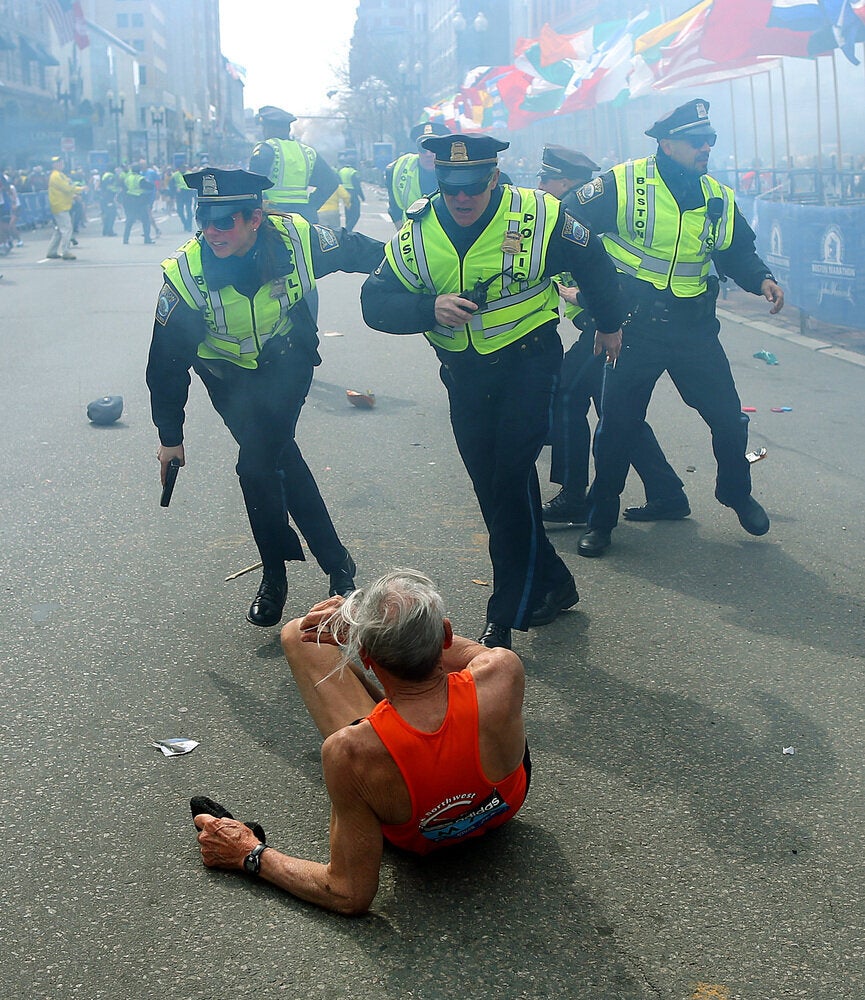
It's a compelling image, to be sure: a young, bespectacled girl, her blonde hair in a ponytail, running alone down a street. She's clad in a too-large orange T-shirt, and a runner's bib on the front bears the name words "Joe Cassella 5K." Below it, her entrant number, 1035.
Beside the photo of the solitary runner, the words "Retweet for Respect" and "R.I.P. to the 8-year-old girl who died in Boston's explosions, while running for the Sandy Hook kids."
Haunting, heartbreaking and utterly fake.
The unidentified, little girl in question wasn't running in the Boston Marathon for Sandy Hook or any other reason on April 15th. Marathons aren't child's play.
She did, however, run the Joe Cassella 5K race in Virginia last May, raising funds for families of sick children to help offset their hospital bills. There's a photo of her on the Joe Cassella Foundation website, taking off from the starting gate, her bright orange T-shirt and number 1035 visible for all to see.
And the Marathon was dedicated to the memory of the 26 victims of the Sandy Hook shooting -- 26.2 miles, one mile marker for each victim.
That's pretty much where the truth ends on this sad story of how Internet trolls manage to take a nugget or two of the truth, combine it with a little magic of Photoshop and concoct a load of soap a carnival huckster would be hard-placed to sell.
The post -- from the "Hope for Boston" Twitter account, which was suspended after many throughout the Twitterverse decried the photo as fake -- had made the rounds hundreds, possibly thousands of times on Twitter, Facebook and other social media sites, seemingly before emergency workers had finished triaging and treating those injured at the scene, and long before the first victim -- eight-year-old Martin Richard, of Dorchester, Mass. -- was identified among the dead.
For every image of Mister Rogers' smiling face, reminding people to "look for the helpers" in times of trouble, and Patton Oswalt's stirring message to the people in Boston on my Facebook news feed, there was this little girl's face, shared by well-meaning friends who only wanted to feel that, in some small way, they had paid tribute to the people impacted by the tragedy.
It didn't move me. It made me angry.
I couldn't help but wonder what kind of individual downloads a photo of a cute little girl running a race, then, with the full knowledge that what they're doing is fraud, fobs it off as the victim of a heinous attack? Was it not tragic enough that we knew three people had died, dozens were seriously injured and thousands profoundly affected by what they heard and saw that someone had to scam the world with a fake victim (or victims) until we knew the faces and names of the real ones?
And (somewhat less charitably, I admit), I also wondered this: Why do intelligent people seem to fall for these charlatans over and over again?
For the record, here they are: Martin Richard, an eight-year-old who pleaded for peace in the world; Krystle Campbell, a 29-year-old who lived with her grandmother and cared for her; and Lu Lingzi, a Chinese student who travelled to Boston to obtain a graduate degree in mathematics and statistics from Boston University.
Think back to the hours and days after Princess Diana died -- the massive outpouring of grief as people struggled to come to terms with what seemed to be the unimaginable loss of a woman they had never met.
Back then, the gates to Kensington Palace literally flooded with flowers, teddy bears, poems and candles. Today, those memorials would be virtual.
I'm not a big fan of that kind of thing. Some, perhaps more cynical than me, would call it grief porn, where people 'like' every memorial page for the tragic event of the week, whether it's a teen's suicide after bullying, shooting victims at an elementary school or a bombing at an event that should have been a source of joy for the 18,000-plus participants and the thousands volunteers, medics and ordinary folks who lined the route to cheer them on.
I prefer to think of it as part of a visceral need to feel a connection to something, even in a peripheral way, to help us comprehend what is seemingly incomprehensible; a kind of reaching out the digital universe in search of a cosmic hug. If it's your thing, that's great. But like online petitions where people manage to muster outrage as far as typing a few words their keyboard but won't step outside to protest in person; this type of social networking isn't my bag.
I know two people who were in Boston for the race. I was beyond relieved in the hours afterward to learn that they were not among those wounded by the shrapnel from the bombs and turned to their Facebook pages to let them know. There were others I knew of who were there -- a teacher at my daughter's high school; a cousin of another friend of mine, and I am equally glad they are coming home safe and, at least physically, sound.
If you're looking to share something on your page connected to the tragedy, share a good news message about someone you know, or a complete stranger. This is a great one.
Post a photo of eight-year-old Martin Richard, the real child killed that day, after rushing out to hug his father at the end of the race. Pray (or, if you're not that way inclined, send the universe good thoughts) for his mother and sister as they recover from critical injuries and for his whole family, as they come to terms with the loss of a child with his whole life ahead of him and for everyone left grappling with the yet-unanswered question, "Why?"
We'll never stop trolls from coming up with new, reprehensible ways to play on a shocked global community's grief. It's what they do and sadly, they do it well enough to fool even the savviest surfer among us.
When next it happens, all we can do is look for the helpers and remember that good people outnumber the trolls, and always will.
